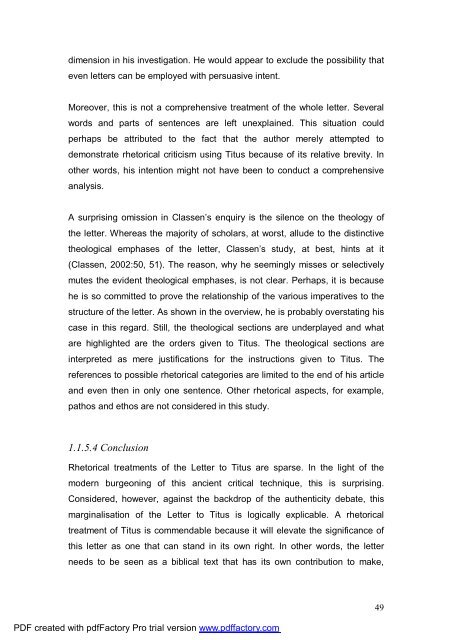A Text centred rhetorical analysis of Paul's Letter to Titus
A Text centred rhetorical analysis of Paul's Letter to Titus
A Text centred rhetorical analysis of Paul's Letter to Titus
Create successful ePaper yourself
Turn your PDF publications into a flip-book with our unique Google optimized e-Paper software.
dimension in his investigation. He would appear <strong>to</strong> exclude the possibility that<br />
even letters can be employed with persuasive intent.<br />
Moreover, this is not a comprehensive treatment <strong>of</strong> the whole letter. Several<br />
words and parts <strong>of</strong> sentences are left unexplained. This situation could<br />
perhaps be attributed <strong>to</strong> the fact that the author merely attempted <strong>to</strong><br />
demonstrate <strong>rhe<strong>to</strong>rical</strong> criticism using <strong>Titus</strong> because <strong>of</strong> its relative brevity. In<br />
other words, his intention might not have been <strong>to</strong> conduct a comprehensive<br />
<strong>analysis</strong>.<br />
A surprising omission in Classen’s enquiry is the silence on the theology <strong>of</strong><br />
the letter. Whereas the majority <strong>of</strong> scholars, at worst, allude <strong>to</strong> the distinctive<br />
theological emphases <strong>of</strong> the letter, Classen’s study, at best, hints at it<br />
(Classen, 2002:50, 51). The reason, why he seemingly misses or selectively<br />
mutes the evident theological emphases, is not clear. Perhaps, it is because<br />
he is so committed <strong>to</strong> prove the relationship <strong>of</strong> the various imperatives <strong>to</strong> the<br />
structure <strong>of</strong> the letter. As shown in the overview, he is probably overstating his<br />
case in this regard. Still, the theological sections are underplayed and what<br />
are highlighted are the orders given <strong>to</strong> <strong>Titus</strong>. The theological sections are<br />
interpreted as mere justifications for the instructions given <strong>to</strong> <strong>Titus</strong>. The<br />
references <strong>to</strong> possible <strong>rhe<strong>to</strong>rical</strong> categories are limited <strong>to</strong> the end <strong>of</strong> his article<br />
and even then in only one sentence. Other <strong>rhe<strong>to</strong>rical</strong> aspects, for example,<br />
pathos and ethos are not considered in this study.<br />
1.1.5.4 Conclusion<br />
Rhe<strong>to</strong>rical treatments <strong>of</strong> the <strong>Letter</strong> <strong>to</strong> <strong>Titus</strong> are sparse. In the light <strong>of</strong> the<br />
modern burgeoning <strong>of</strong> this ancient critical technique, this is surprising.<br />
Considered, however, against the backdrop <strong>of</strong> the authenticity debate, this<br />
marginalisation <strong>of</strong> the <strong>Letter</strong> <strong>to</strong> <strong>Titus</strong> is logically explicable. A <strong>rhe<strong>to</strong>rical</strong><br />
treatment <strong>of</strong> <strong>Titus</strong> is commendable because it will elevate the significance <strong>of</strong><br />
this letter as one that can stand in its own right. In other words, the letter<br />
needs <strong>to</strong> be seen as a biblical text that has its own contribution <strong>to</strong> make,<br />
PDF created with pdfFac<strong>to</strong>ry Pro trial version www.pdffac<strong>to</strong>ry.com<br />
49

















